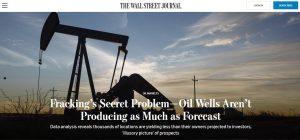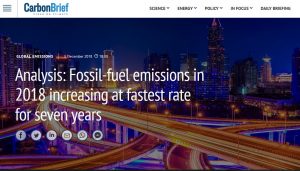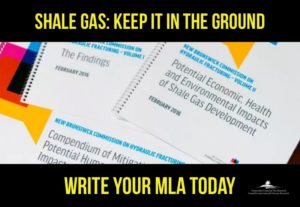January is a popular time for reviewing the previous year to see where we are now. Since I write about the shale gas industry and global warming, let me share some annual reports from both, along with some commentary.
Fracking in 2018: Another Year of Pretending to Make Money: This has my vote for best title. The author notes that the 60 largest U.S. fracking companies have been accumulating losses at about $80 million per year for a decade. Investors and lenders lost $70 billion in loans due to 330 North American bankruptcies following the price crash of 2014, and last year The Wall Street Journal calculated industry debt around $180 billion.
2018 was supposed to be the year that the industry would finally start being profitable. But the first half of the year found companies still spending $3.9 billion more on drilling from January through June than they generated by selling oil and gas.
 Many people wonder how such a money-losing enterprise for investors can keep attracting them. One good answer to that puzzle appeared as a recent front-page story in The Wall Street Journal: Fracking’s Secret Problem – Oil Wells Aren’t Producing as Much as Forecast.
Many people wonder how such a money-losing enterprise for investors can keep attracting them. One good answer to that puzzle appeared as a recent front-page story in The Wall Street Journal: Fracking’s Secret Problem – Oil Wells Aren’t Producing as Much as Forecast.
It’s technically a five-year review, but because of its appearance in the first weeks of January, I’ll treat it is an annual retrospective. It concludes that the shale industry has simply overstated to investors how much oil and gas shale wells would produce.
Based on an analysis of some 16,000 wells operated by the 29 largest producers, and confirmed by three separate energy consulting firms, it seems two-thirds of projects were “overly optimistic” about production.
Like many resources, shale gas and oil tend to be concentrated in “sweet spots,” where they are easy and cheap to extract in plentiful quantities. Of course, everyone drilled these sweet spots first and their big production numbers were often extrapolated to forecast the production at all subsequent wells. Forecasts were also based on well lifespans as long as 50 years.
But shale well production has proven to rapidly drop after one or two years, and cease significant production in five years or so. Also, wells drilled outside of sweet spots cost more and produced significantly less.
The big production from sweet spots flooded the market and lowered prices, meaning that most production has been sold at prices that don’t cover costs. If prices eventually go up, there will be less production to be sold at those prices. Some big projects in the Eagle Ford and Permian plays are producing from 25 per cent to 63 per cent less than forecast.
All of this led to the The Wall Street Journal report’s conclusion that “thousands of shale wells drilled in the last five years are pumping less oil and gas than their owners forecast to investors, raising questions about the strength and profitability of the fracking boom.”
Since 2008, an index of U.S. oil and gas companies has fallen 43 per cent, while the S&P 500 index has more than doubled. In the last two years, equity stakes in shale oil companies have fallen from some $35 billion to roughly $6 billion. As Capital raising by US oil exploration and production companies has fallen sharply, maybe investors are finally paying attention.
The evidence of environmental damage is mounting
The annual numbers everyone should be paying attention to are these:
2018 – the hottest La Nina year ever recorded and the fourth hottest year on record. La Nina years are usually cooler. The past five years are the five hottest since the launch of reliable global measurements more than a century ago.
2018 was the hottest year ever recorded for the planet’s oceans.
The last five years are also the ocean’s five hottest. Since the oceans absorb 90 per cent of the heat trapped by greenhouse gasses (GHG’s), this is a dark omen, as is the increasing rate of ocean warming, which will be six times greater in the next 60 years than the last 60.
 Analysis: Fossil-fuel emissions in 2018 increasing at the fastest rate for 7 years. 2018 saw record high measured levels of the GHG’s carbon dioxide, methane and nitrous oxide. At a time when we need to be steadily decreasing our emissions, they are increasing at a greater rate.
Analysis: Fossil-fuel emissions in 2018 increasing at the fastest rate for 7 years. 2018 saw record high measured levels of the GHG’s carbon dioxide, methane and nitrous oxide. At a time when we need to be steadily decreasing our emissions, they are increasing at a greater rate.
One climate researcher, discussing the approach of climate tipping points, said, “We’re surprised at the rate of change in the Earth’s system. So much is happening at the same time and at a faster speed than we would have thought 20 years ago. That’s a real concern … We’re heading ever faster towards the edge of a cliff.”
The extreme weather disasters associated with climate change in 2018 were costly. Take your pick of rival insurance company estimates:
- Extreme weather cost global economy $215bn in 2018, AON estimates
- ‘Severe and costly’: 2018 clocks in $160bn worth of extreme weather damages from Munich RE.
Either figure was likely enough to help make “extreme weather” the number one risk cited in the ‘Global Risks Report’, produced for the world’s rich folks currently meeting in Davos. The number two risk is the failure by governments to deal with climate change.
You can find a catalogue of some of the disasters at 2018: A Year of Deadly Climate Disasters and an ‘Ear Splitting Wake-Up Call’, another good title.
As I write, new studies indicate that the melting of the Greenland ice may have reached a tipping point, and Antarctic ice is melting much faster than thought – as is the world’s permafrost, one of the most dangerous feedback loops.
Of course, there were some positive trends like: Clean Power Sees First Win Over Fossil Fuels in Emerging Markets, and Electricity from renewables topped coal in Germany for first time in 2018.
N.B. heading down the wrong path
But, positive or negative, here in New Brunswick, we’re not paying attention to any of the implications contained in these annual reviews.
Instead, our government plans to tie our future to a shale gas industry that isn’t solvent and bring us the tarsands-expanding Energy East pipeline and an LNG terminal. Each project is years from being realized.
Each will also drastically increase our emissions of GHG’s and preclude the province from meeting any GHG limits. And as we are increasingly squeezed by climate change, each may have a very short lifespan. Is this evidence-based public policy?
If we don’t pay attention to what happened in 2018, the economic and environmental retrospectives of 2019 will make dismal reading indeed.
Jim Emberger is the spokesperson for the New Brunswick Anti-Shale Gas Alliance. This article originally appeared in Huddle Today on Jan. 27. It, and other informative articles by Mr. Emberger can be found at the NBASGA website.


